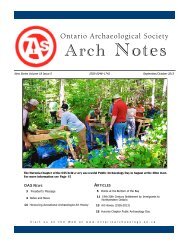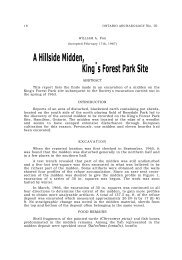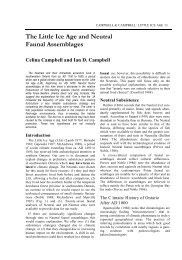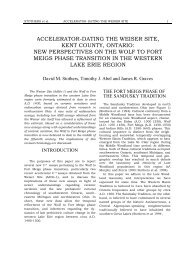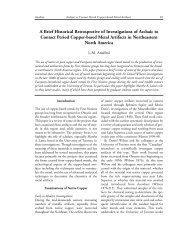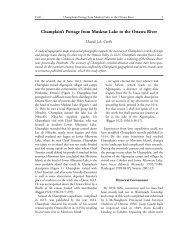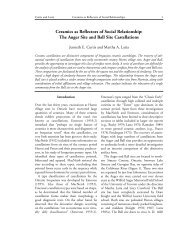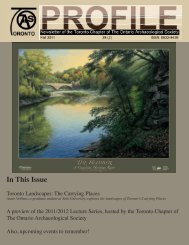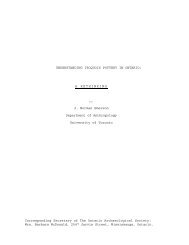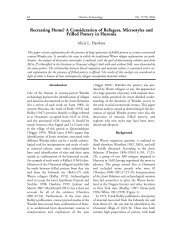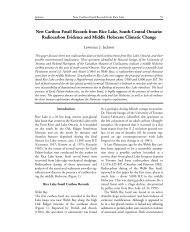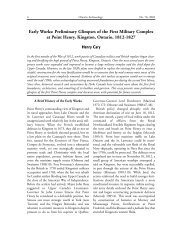Huron-St. Lawrence Iroquois Relations in the Terminal Prehistoric ...
Huron-St. Lawrence Iroquois Relations in the Terminal Prehistoric ...
Huron-St. Lawrence Iroquois Relations in the Terminal Prehistoric ...
You also want an ePaper? Increase the reach of your titles
YUMPU automatically turns print PDFs into web optimized ePapers that Google loves.
32 ONTARIO ARCHAEOLOGY NO. 44Bone ToolsJefferson County and <strong>Huron</strong> bone tools alsoshare similarities. Beauchamp (1902:P1.5 No. 47,P1.8 No. 84) illustrates carved bone p<strong>in</strong>s fromJefferson County which closely resemble <strong>the</strong>carved and sometimes decorated carved bone p<strong>in</strong>srecorded by Emerson (1954:90, 93, 186, 189, 190,204, 209, 210) on <strong>the</strong> late prehistoric Hard-rock siteand <strong>the</strong> protohistoric Benson site. Both <strong>the</strong>se are<strong>Huron</strong> sites <strong>in</strong> Victoria County.Beauchamp (1902:P1.11 No. 114) also illustratesa bone dagger-like tool from Jefferson Countywhich resembles <strong>the</strong> bone dagger-like tools excavatedon <strong>the</strong> late prehistoric <strong>Huron</strong> Payne andWaupoos sites <strong>in</strong> Pr<strong>in</strong>ce Edward County(Pendergast 1963:6; 1964:70, 87). Emerson alsorecords a similar specimen from <strong>the</strong> prehistoric<strong>Huron</strong> site at Downsview (1954:102).OssuariesThe <strong>Huron</strong> Feast of <strong>the</strong> Dead and <strong>the</strong> associated<strong>Huron</strong> custom of ossuary burial are well known(Tooker 1964:134). However <strong>the</strong> existence ofossuaries <strong>in</strong> Jefferson County is not as well known,although <strong>the</strong>ir presence has long been recorded. By1849 Squire had located two bone pits which hedescribed as follows:One is found near <strong>the</strong> village of Brownville,on Black River. It is described as a pit, ten ortwelve feet square, by perhaps four feet deep,<strong>in</strong> which are promiscuously heaped toge<strong>the</strong>r alarge number of human skeletons. It will beseen ultimately, that <strong>the</strong>se accumulations owe<strong>the</strong>ir orig<strong>in</strong> to a remarkable custom, common tomany Indian tribes, of collect<strong>in</strong>g anddeposit<strong>in</strong>g toge<strong>the</strong>r <strong>the</strong> bones of <strong>the</strong>ir dead, atstated <strong>in</strong>tervals.Ano<strong>the</strong>r pit, very unlike this, however, existsabout three miles east of Watertown. It issituated upon <strong>the</strong> slope of a hill, and wasorig<strong>in</strong>ally marked by a number of large stonesheaped over it. Upon remov<strong>in</strong>g <strong>the</strong>se and excavat<strong>in</strong>gbeneath <strong>the</strong>m, a pit about six feetsquare, and four feet deep, was discovered,filled with human bones, all well preserved,but <strong>in</strong> fragments. Upwards of forty pairs ofpatella were counted, show<strong>in</strong>g that at least thatnumber of skeletons had been deposited <strong>in</strong> <strong>the</strong>pit. . . All <strong>the</strong> bones are those of adults.. . Norelics of any k<strong>in</strong>d were found with <strong>the</strong>m(Squire 1851:25-26).Hough (1850:102-103) located <strong>the</strong> ossuarydescribed by Squire "three miles east of Watertown"as hav<strong>in</strong>g been found <strong>in</strong> 1842 <strong>in</strong> Rutland on acommand<strong>in</strong>g height on <strong>the</strong> farm of E. Hunt<strong>in</strong>g-ton.He adds <strong>the</strong> <strong>in</strong>formation that <strong>the</strong> pit was covered byflat circular stone under <strong>the</strong> stone pileand that <strong>the</strong> pit was "four feet square and two feetdeep filled with bones thrown promiscuouslytoge<strong>the</strong>r". He estimates "between thirty to fortyskeletons were buried here." Later Hough (1854:13-14) remarked `bone pits' were common <strong>in</strong> JeffersonCounty before recount<strong>in</strong>g Squire's account of <strong>the</strong>Brownville ossuary add<strong>in</strong>g <strong>the</strong> comment that "agreat deal of skeletons" had been thrown <strong>in</strong> <strong>the</strong> pit.His account of <strong>the</strong> Rutland ossuary added <strong>the</strong><strong>in</strong>formation that <strong>the</strong> pit was "filled with bones ofmen and animals <strong>in</strong> great con-fusion" (italicsadded). He estimated <strong>the</strong> bones of forty people werepresent. Hough also provides <strong>in</strong>-formation on a third<strong>the</strong>retofore unreported ossuary "<strong>in</strong> Ellisburg nearlyopposite an ancient earthwork on Sandy Creek neara house occupied by J.W. Ellis, where <strong>in</strong> digg<strong>in</strong>g acellar <strong>in</strong> 1818 [human] bone <strong>in</strong> great numbers werefound."Beauchamp (1886:112) acknowledges <strong>the</strong>presence of "bone pits <strong>in</strong> Brownville, Ellisburg andelsewhere" (italics added) without elaborat<strong>in</strong>g. Hetwice remarks <strong>the</strong>y are <strong>in</strong>dicative of <strong>Huron</strong> customsand "a th<strong>in</strong>g of special <strong>in</strong>terest <strong>in</strong> Jefferson County ...which suggests <strong>the</strong> ossuaries of Canada but on amuch smaller scale" (Beauchamp 1886:125). Laterhe noted "<strong>in</strong> Jefferson County ... <strong>the</strong>re are somesmall bone pits suggest<strong>in</strong>g this custom [Feast of <strong>the</strong>Dead] but I know of none among <strong>the</strong> eastern<strong>Iroquois</strong>," <strong>the</strong> Onondaga, Oneida and Mohawk(Beauchamp 1889:135). Much of this he reiterates<strong>in</strong> his Aborig<strong>in</strong>al Occupation of New York <strong>St</strong>atenot<strong>in</strong>g aga<strong>in</strong> that <strong>the</strong> "ossuaries show <strong>Huron</strong> ideasprevailed among <strong>the</strong> New York <strong>Iroquois</strong>"(Beauchamp 1900:79).In his comments on Cusick's Sketches of AncientHistory of <strong>the</strong> Six Nations, Beauchamp remarks(1892:80, 108) "Except <strong>in</strong> Jefferson County bonepits barely occur as far east as Onondaga" and aga<strong>in</strong>"There are ossuaries <strong>in</strong> Jefferson County, NewYork, but <strong>in</strong> no great numbers."Woodworth (1895:53) noted <strong>the</strong> presence of whatmay be an ossuary south of Rutland on "<strong>the</strong> Allenplace" without fur<strong>the</strong>r details.Edgar Emerson (1898:474) notes <strong>the</strong> existence of<strong>the</strong> ossuary at Brownville and provides <strong>the</strong> additional<strong>in</strong>formation that it was ten or twelve feetsquare. He believed it was associated with <strong>the</strong> Feastof <strong>the</strong> Dead. Emerson located <strong>the</strong> pit on <strong>the</strong> "northbank of Black River below Brownville a little belowand on <strong>the</strong> opposite side of <strong>the</strong> road from <strong>the</strong> presentvillage cemetery near where a small rav<strong>in</strong>ecrosses <strong>the</strong> highway." He also provides <strong>the</strong> <strong>in</strong>formationthat <strong>the</strong> Rutland ossuary was located "on<strong>the</strong> farm of T.E. Beecher on <strong>the</strong> left side of <strong>the</strong> roadlead<strong>in</strong>g north from his house just above <strong>the</strong> turn(about 15 rods from <strong>the</strong> road) on a graduallyslop<strong>in</strong>g hillside." He notes <strong>the</strong> pit was six feetsquare and four feet deep and "More than forty pair



